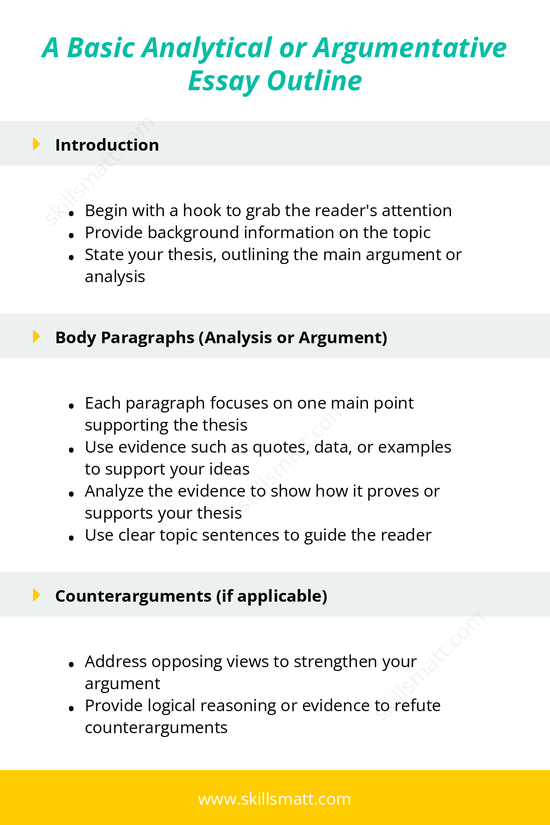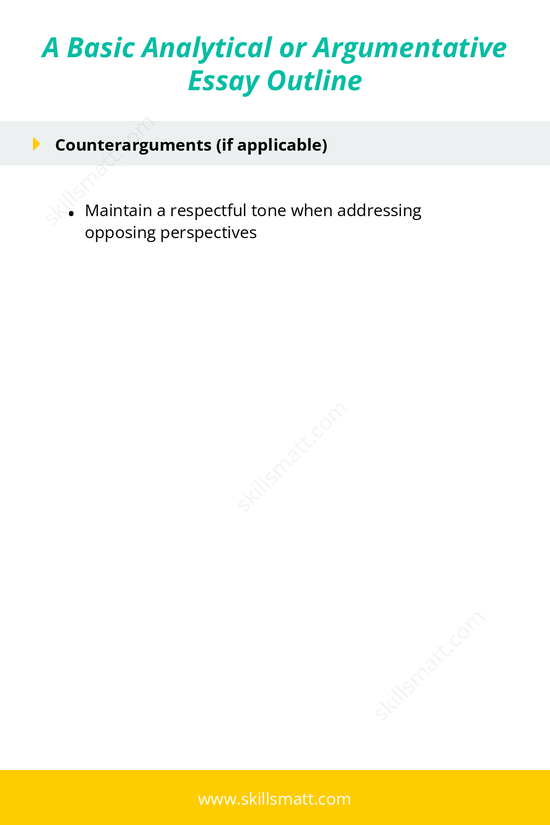Writing a basic analytical or argumentative essay requires a structured approach to present a coherent and compelling argument. Whether you're analyzing a topic or defending a viewpoint, the essay should have a clear structure to guide the reader through your reasoning. Here’s a breakdown of the key components of an analytical or argumentative essay, along with additional insights to help you craft a persuasive and well-supported essay.
Introduction
The introduction is the first opportunity to grab the reader’s attention and set the stage for your argument or analysis. It is crucial that you establish a strong foundation right from the beginning.
- Begin with a hook: A compelling hook is essential to engage the reader from the start. This can be a thought-provoking question, a surprising statistic, or an interesting anecdote related to your topic. A strong hook draws the reader in and makes them want to continue reading.
- Provide background information: After the hook, you should provide some context to help the reader understand the issue or topic you are addressing. This might include historical context, an explanation of key concepts, or a brief overview of the issue.
- State your thesis: The thesis statement is the backbone of your essay. It should clearly outline the main argument or analysis you will present in the body paragraphs. Your thesis should be specific, concise, and debatable, providing a clear direction for the essay.
Body Paragraphs (Analysis or Argument)
The body paragraphs are where the bulk of your argument or analysis is developed. Each paragraph should focus on a single point that supports your thesis, and you must provide solid evidence to back up your claims.
- Focus on one main point per paragraph: Each paragraph should address one specific point that supports your thesis. Start each paragraph with a clear topic sentence that introduces the point, and then build on it throughout the paragraph.
- Use evidence to support your ideas: To make your argument persuasive, you need to back it up with credible evidence. This could include quotes from experts, statistical data, or specific examples that illustrate your point. Always ensure your evidence is relevant and reliable.
- Analyze the evidence: Simply providing evidence is not enough. You must also explain how it supports your thesis. This analysis is crucial because it shows the reader why the evidence is important and how it strengthens your argument. Avoid simply summarizing the evidence—dive deeper into its meaning and implications.
- Use clear topic sentences: Each body paragraph should begin with a topic sentence that clearly indicates the point being made. The topic sentence helps the reader follow the structure of your essay and understand how each point ties back to your thesis.
Counterarguments (if applicable)
Addressing counterarguments is an important part of strengthening your essay. By acknowledging opposing viewpoints, you demonstrate that you’ve thought critically about the issue and are capable of defending your stance.
- Address opposing views: Acknowledge the most significant counterarguments to your thesis. By presenting opposing viewpoints fairly, you show that you understand the complexity of the issue. This strengthens your credibility as a writer.
- Refute the counterarguments: After presenting opposing views, you need to provide logical reasoning or evidence to refute them. This could involve showing flaws in the logic of the opposing argument, providing stronger evidence, or explaining why your argument is more compelling. The goal is to demonstrate that your perspective holds more weight.
- Maintain a respectful tone: While it’s important to challenge opposing viewpoints, you should always do so respectfully. Avoid dismissing or belittling opposing arguments. A respectful tone strengthens your argument and makes your writing more persuasive.
Conclusion
The conclusion is your final opportunity to leave a lasting impression on the reader. A well-crafted conclusion will not only summarize your key points but also reinforce your thesis and provide broader implications.
- Restate the thesis: In the conclusion, restate your thesis in light of the evidence and arguments you’ve presented. This helps remind the reader of your main argument and reinforces the validity of your position.
- Summarize key points: Briefly summarize the key points you made in the body paragraphs. This helps the reader recall the most important aspects of your argument and reinforces the logical flow of your essay.
- End with a final thought: A strong conclusion leaves the reader with something to think about. This could be a call to action, a reflection on the broader implications of the issue, or a final thought that ties everything together. The conclusion should provide closure while also encouraging the reader to reflect on your argument.
Writing an analytical or argumentative essay requires a clear structure and well-supported arguments. By following this outline, you can ensure that your essay is coherent, persuasive, and thoroughly developed. Remember, the strength of your argument relies on the evidence you provide and the analysis you offer, so take the time to develop each section carefully. With practice, you’ll be able to write essays that are not only effective but also intellectually engaging and thought-provoking.


